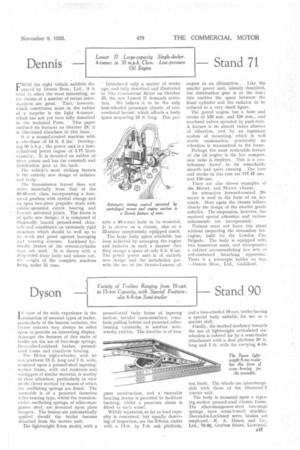Dennis
Page 169

If you've noticed an error in this article please click here to report it so we can fix it.
Lancet II Large-capacity Single-decker. 4-tanner in 30 m.p.h. Class. Low-pressure Oil Engine.
Stand 71
FROM the eight vehicle exhibits displayed by Dennis Bros., Ltd., it is hard to select the most interesting, as the claims of a number of recent intrOauctions are great: That, however, which constitutes more in the nature of a surprise is the light 4-tonner, which his not yet been fully described in the technical Press. • This paper outlined its features on October 25; it is illustrated elsewhere in this issue.
It is a normal-control. machine with a wheelbase 'of 14 ft. 6, . Developing 60 b.h.p., the power unit is a fourcylindered petrol engine of 3.77 litres capacity. It is mounted on rubber at three points and has the camshaft and distribution gear at the back.
The vehicle's most striking feature is the entirely new design of radiator and body.
The transmission layout does not differ materially from • that of the 40-45-cwt, class, incorporating a fourspeed gearbox, with central change and an open two-piece propeller shaft with rubber-mounted centre bearing and Layrub universal joints. The frame is of quite new design ; it is composed of diagonally braced . pressed-steel channels and constitutes an extremely rigid structure which should be well up to its work and proof against lozenging and weaving stresses. Lockheed hydraulic brakes of the remote-cylinder type are used. It is shown with a drop-sided lorry body and saloon cab, the weight of the complete machine being under 2 tons.
Introduced only a matter of weeks ago, and fully described and illustrated in The Commercial Moto; on October 25, the new Lancet II demands attention. We believe . it •to be the only four-wheeled passenger chassis, of conventional layout; Which affords a body space measuring 24 ft. long. This per
mite a 40-seater body to be mounted. It is shown as a chassis, also as a 32-seater sumptuously equipped coach.
The large body space .available has been achieved by arranging the engine and radiator in such a manner that they occupy a space of only 3 ft. 6 ins. The petrol power unit is of entirely new design and the installation permits the use of the Dennis-Lanova. oil engine as an alternative. Like the smaller power unit, 'already 'described, the distribution gear is at the rear ; this enables the space between the front cylinder and the radiator to be reduced to a very small figure, . .
The petrol engine has a bore and stroke of 120.nim.. and 150 mm., and Overhead valves operated by push-rods. A. feature is its almost entire absence of vibration, and by an ingenious system of _mounting, which is well • worth examination, practically no vibration is transmitted to the frame.
Perhaps the most noticeablefeature of the oil engine is the low compression ratio it employs. This is a contributory factor to its remarkably smooth and quiet limning. The bore and stroke in this case are 117.47 min and lr.)0
There are also shown examples of the 50-cwt. and 70-cwt. chassis;
• An attractive forward-control 20seater is seen' in the form of an Ace coach. Here again the chassis follows closely the design of the smaller-goods vehicles. ' Thesiispension, however, has received special attention and various refinements • are Mcorporateds
Visitors must not leave., this stand without inspecting the streamline fireengine, built for the London Fire Brigade. The body is equipped with two transverse seats, and incorporates a cabinet accommodating five sets of self-contained breathing apparatus. There is a telescopic ladder on top. —Dennis Bros., Ltd., Guildford.












































































































































































































































































































